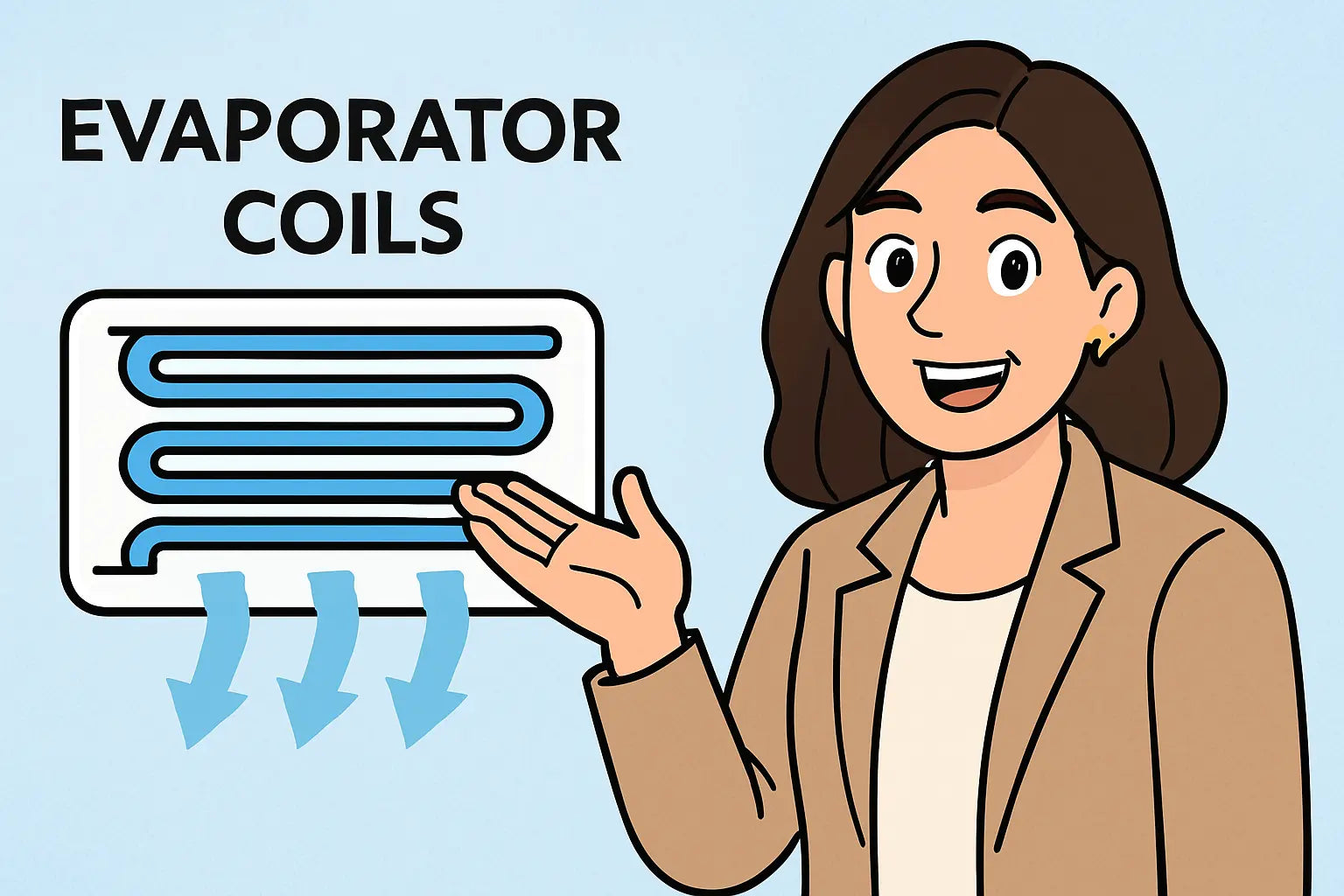Mavi Here – Let’s Talk About Leaks 💬🧊
Hey there, home hero! 🙋
Look, nobody likes the word “leak” unless we’re talkin’ hot gossip. But when it comes to your evaporator coil, leaks are no joke. A sneaky refrigerant leak can wreck your system’s performance, send your utility bills sky-high, and, yep, even damage your home.
So, if you’ve got puddles, poor cooling, or suspicious hissing sounds near your air handler—it’s time to investigate. Let’s break down what causes a leaky coil, how to deal with it, and when it’s time to say goodbye and replace it.
What Is a Leaky Evaporator Coil, Anyway?
Your evaporator coil carries refrigerant, and it’s designed to absorb heat from your home. It’s made from copper or aluminum tubing and usually located in a sealed cabinet above your furnace or inside your air handler.
Over time, that tubing can develop tiny holes—some no bigger than the tip of a pin—due to corrosion, vibration, or manufacturing flaws. And when that happens? You’ve got a refrigerant leak on your hands. 😬
According to Waychoff's Air Conditioning, evaporator coil leaks are one of the most common causes of cooling failure in residential HVAC systems.
The 3 Biggest Causes of Coil Leaks 🔍
1. Formicary Corrosion
No, that’s not a Harry Potter spell—it’s real. Caused by acids in household air (often from cleaning products), formicary corrosion eats away at the inside of copper coils, creating hairline cracks.
PV HVAC describes it as “the silent destroyer” of coils.
2. Poor Airflow or Dirty Filters
Clogged filters and blocked vents mean the system works harder, increasing coil pressure and temperature. Over time, this strain can cause cracks and leaks.
3. Mechanical Vibration or Poor Installation
Bad mounting or poor support can cause the coil to vibrate—especially during startup and shutdown. Those micro-movements? Yeah, they wear out solder joints and cause leaks.
Signs Your Evaporator Coil Is Leaking 🕵️
Here’s what to look (and listen!) for:
-
Hissing or bubbling sounds
-
Warm air from your vents even when the AC is on
-
Ice forming on the coil
-
Low refrigerant pressure readings (techs will spot this)
-
Higher-than-usual energy bills
-
Visible water pooling under the unit
Still not sure? This Carrier Learning Center article has a fantastic breakdown on how to spot the symptoms of coil failure.
Can You Fix a Leaky Coil? Let’s Break It Down 👇
Short answer: sometimes—but usually, it’s not worth it.
Here are your main options:
Option 1: Spot Repair
If the leak is easy to reach and small enough, a pro might be able to braze it shut. But... this is usually a Band-Aid, not a cure.
Pros: Quick, cheaper upfront
Cons: Doesn’t fix deeper corrosion or prevent future leaks
Option 2: Add Leak Sealant
There are refrigerant additives that claim to seal small leaks from the inside. These are hit-or-miss and not a long-term solution, especially for formicary corrosion.
Pros: Super cheap
Cons: Can clog TXVs, void warranties, or worsen the problem
Option 3: Full Coil Replacement
This is the only real fix if your coil is aging, corroded, or leaking in multiple spots.
Pros: Long-term reliability, restored efficiency
Cons: Costly, but often cheaper than constant repairs
Want a peek at pricing? HVAC.com gives a handy cost breakdown for common evaporator coil replacements—usually in the $600–$2,000 range, depending on system size and brand.
Should You Replace the Whole System Instead? 🧐
Good question. Here’s the Mavi Rule of Thumb:
-
If your coil is more than 10 years old
-
If your system still uses R-22
-
If you’re already needing frequent AC repairs
-
Or if your coil and condenser don’t match anymore
…it’s often smarter to replace both the coil and condenser unit to boost SEER2 efficiency and avoid mismatches.
Energy Star agrees: matched systems work better, save energy, and prevent performance issues.
How to Prevent Future Coil Leaks (Yes, You Can!) 🧼🌬️
-
Change your air filter every month
-
Seal duct leaks to prevent unfiltered air from entering the coil cabinet
-
Avoid VOC-heavy cleaners around your air intake (think bleach sprays, aerosols, etc.)
-
Install a whole-home air purifier or UV light system to reduce corrosive particles
-
Schedule annual HVAC inspections to catch issues early
Want more proactive tips? The EPA's IAQ guide is packed with ways to keep your indoor air clean—and your coils safer.
Mavi’s Final Word on Coil Leaks 💬🛠️
Leaks happen. But they don’t have to ruin your season—or your sanity.
Whether you’re hearing the dreaded hiss or staring at a suspicious puddle under your system, now you know how to spot the signs, understand your options, and make a smart call.
If it’s time for a replacement, don’t panic. Check out The Furnace Outlet’s evaporator coil collection for top-rated options that ship fast and match common setups.
Don't know if vertical or horizontal coils are right for your system? Visit: Coil Showdown.
I’ve said it before and I’ll say it again—your HVAC system doesn’t have to be a mystery. You’ve got this. And you’ve got me in your corner.
Until next drip…
– Mavi 💙💧







